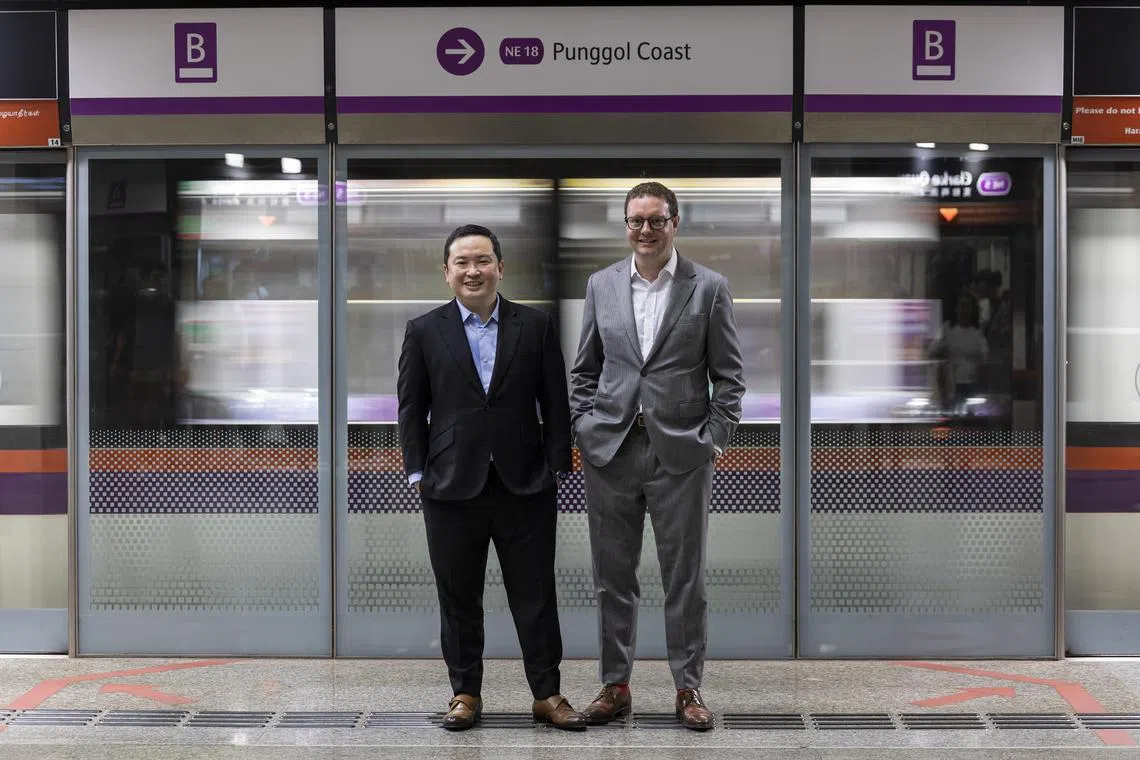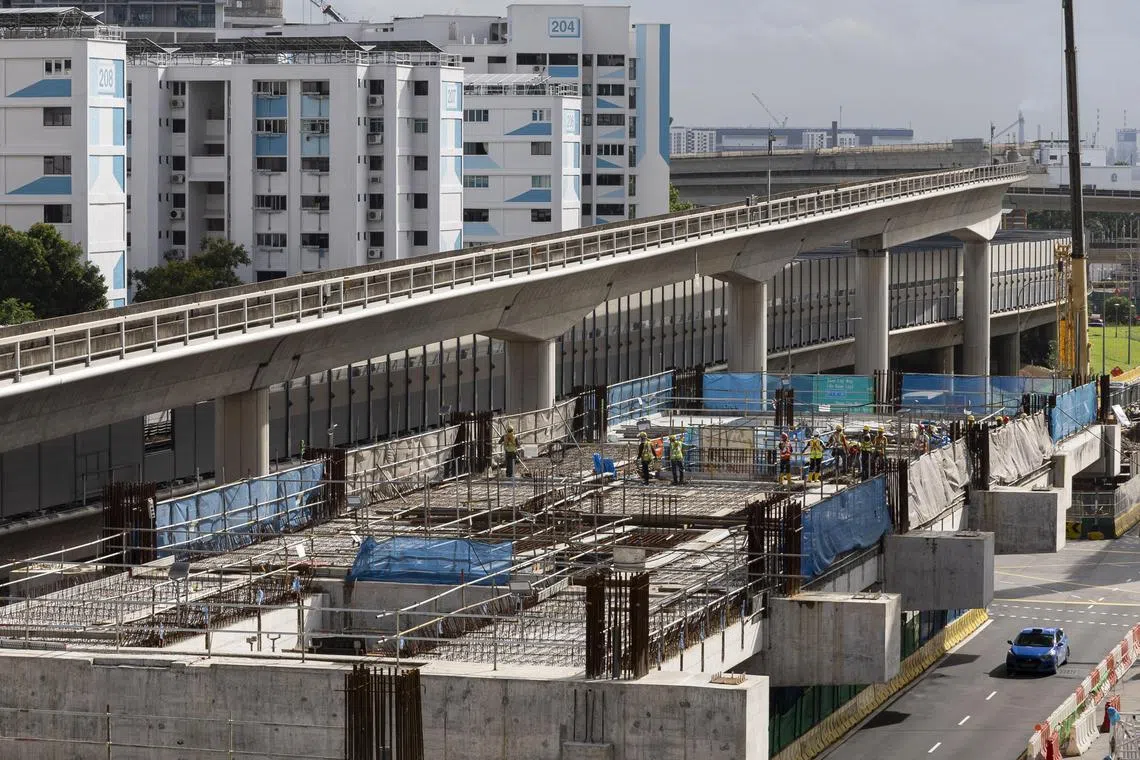SBS Transit tie-up with French firm RATP Dev aims to bring best of the world to Jurong, say CEOs
Sign up now: Get ST's newsletters delivered to your inbox

Mr Jeffrey Sim (left), SBST's chief executive, and Mr Henri Pottier, RATP Dev's regional chief at Clarke Quay MRT station.
ST PHOTO: BRIAN TEO
Follow topic:
SINGAPORE - Preparations to operationalise the upcoming Jurong Region Line (JRL) are ratcheting up, with a joint venture between Singapore public transport operator SBS Transit (SBST) and French transport company RATP Dev now up and running.
A number of its key executives have also been installed.
This comes after the joint venture was appointed to run the JRL
The joint venture, Singapore One Rail, won the JRL contract with a $750 million bid to operate the line for nine years, with an optional two-year extension. This was 8 per cent lower than the other bid made by rail operator SMRT.
SBST has a 75.01 per cent stake in the venture, with RATP Dev holding the remaining 24.99 per cent, according to business records.
Mr Anthony Mok Peng Fai, head of the SBST-run North East Line (NEL) and Sengkang-Punggol LRT, has been appointed the joint venture’s chief executive. SBST’s group chief executive Jeffrey Sim and Downtown Line head Lee Yam Lim are directors.
The trio will form part of a core leadership team of about 15 that will include senior executives from RATP Dev, said Mr Sim in a joint interview with RATP Dev’s Asia-Pacific chief executive Henri Pottier earlier in January.
This team will oversee what Mr Sim said is an elaborate mobilisation plan, which includes progressively hiring and training an estimated 1,000 workers who will be needed to run the 24-station above-ground line.
Specific operational procedures that will incorporate SBST’s best practices, as well as those from RATP Dev’s rail operations across five continents, will also be developed, Mr Sim said.
For passengers travelling on the JRL, what this means is that they will get the best that the world has to offer in terms of rail safety, reliability and customer experience, he added.
Noting the French company’s technical know-how, its access to a global talent pool, and the tools it has developed to run other driverless rail lines in cities such as Sydney in Australia and Doha in Qatar, Mr Sim said: “We see a lot of value in what RATP will bring because they will be the conduit, not just to Paris, but also to their global operations.”
One example of this is the JRL’s use of fully automated three-car trains made by Hyundai Rotem – the first time the South Korean company is supplying trains here.
While SBST has been engaging the manufacturer to better understand the train’s behaviour and reliability, RATP Dev has had experience maintaining Hyundai Rotem trains.
Hence, the head of rolling stock for the JRL will be from RATP Dev, Mr Sim said.
Another strength that SBST hopes to leverage is RATP Dev’s data analytics and condition-monitoring capabilities.
That is why the JRL will use a customised version of RATP Dev’s in-house maintenance software, which Mr Sim said complements SBST’s efforts to use such technologies for its existing MRT lines.
Mr Pottier said this piece of software has been developed over 15 years to understand and better manage equipment failures, so action can be taken early.
The Frenchman, who has been based in Singapore since 2019, said RATP Dev will also bring to the joint venture its parent company RATP Group’s experience as the Paris metro system’s asset owner – a role that the Land Transport Authority (LTA) plays in Singapore’s rail sector.
“It was a natural challenge for us to measure ourselves to the very high standards of Singapore, and convince LTA that we could bring something in,” Mr Pottier said, when asked about the significance of the French firm’s participation here.
“The Jurong line will be our 12th driverless line, so we know what we are doing,” he added.
Mr Sim said the benefits of the partnership extend to the broader rail sector, too.
For instance, with the 21-year-old NEL expected to undergo a renewal of its systems in the next decade, RATP Dev’s recent experience of replacing the signalling system for the driverless Line 14 in Paris will come in handy.
“By opening up in such a manner, where RATP Dev takes an equity stake in the operating company, it allows us to tap their expertise in a more pervasive way,” said Mr Sim.
“Some may say we lost a certain percentage of profits to RATP Dev as part of the partnership, but I don’t look at it that way.”
SBST and SMRT were invited to submit bids to run the JRL
Foreign operators were allowed to take part through joint ventures, but only as minority partners with less than 25 per cent shareholding.
The future Cross Island Line was also part of the tender, but LTA said in November 2024 it would award that contract later.
Industry watchers said opening up Singapore’s rail sector to foreign participation, even if it is limited to a minority stake, should lead to economies of scale and knowledge transfers.
“This is a healthy development,” said NUS transport economist Timothy Wong. “Rail operations are a very small market locally, so to be more efficient, we need to look beyond the borders of Singapore.”
But Dr Wong and Singapore University of Social Sciences transport economist Walter Theseira both agreed that there will, and should, continue to be a strong local presence in the rail sector, given the industry’s essential role.
Neither expert foresees a third rail operator apart from SBST and SMRT, whether foreign or Singaporean, entering the market independently, either.
“More foreign participation may happen in the form of more joint ventures with local firms, but these firms will likely maintain a minority stake, so that Singaporean interests are always protected,” Dr Wong said.
When completed, the 24km JRL will connect key areas in Singapore’s west, including the Jurong Industrial Estate, Jurong Innovation District and Nanyang Technological University (NTU).
A daily ridership of 200,000 trips is expected in the initial years, rising to more than 500,000 a day in tandem with future developments.
A unique JRL feature is its multiple branches, which require passengers to transfer between trains at stations in Bahar Junction and Tengah to get to different parts of the line.

Construction of the JE4 station as part of the Jurong Regional Line along Toh Guan road at Jurong East on Jan 16.
ST PHOTO: BRIAN TEO
Mr Pottier said this is something RATP Dev has experience with in Paris.
“It’s something we have to look at and make sure procedures and protocols are in place... What is important is to ensure that every passenger who reaches the platform is perfectly comfortable to take the train in the right direction,” he added.
Mr Sim said passenger experience is key, citing plans to set up a customer experience innovation lab at a JRL station, where passengers will be roped in to test and give feedback on new technologies and solutions.
A tie-up between SBST and bicycle-sharing company Anywheel will also be extended to the JRL to bolster first- and last-mile connectivity, especially in industrial estates.
Mr Sim noted the importance of community engagement, too, adding that there are plans to get NTU and its students involved to add vibrancy to the stations on the university’s campus.
On a broader level, the JRL contract also represents the next step in a deepening relationship between SBST and RATP Dev that started five years ago, said Mr Sim and Mr Pottier.
They pointed to an earlier partnership between ComfortDelGro, SBST’s parent company, and RATP Dev to compete for the operation of new rail lines in Paris.
This culminated in a successful bid to run the southern sector of the French capital’s Line 15 from 2026 as part of an international consortium that includes French train manufacturer Alstom.
Most recently, ComfortDelGro and RATP Dev formed a consortium on Jan 21 to bid for an upcoming contract to operate the Copenhagen metro system
These moves also bolster ComfortDelGro’s international portfolio, which includes other overseas ventures that run rail lines in Auckland in New Zealand and, soon, Stockholm in Sweden.
Mr Sim said the relationship with RATP Dev is a reciprocal one, noting that ComfortDelGro staff have already been deployed in Paris to helm customer experience for Line 15.
Mr Pottier added: “The values are very aligned between the two companies. This is why we came together. Working in each other’s domestic markets is a very strong and powerful link.”
However, Mr Sim and Mr Pottier said the partnership will not extend to bus operations in Singapore.
“The bus set-up works well here, and if we don’t have something new to bring, we are not here to compete for competition’s sake,” Mr Pottier said.
Kok Yufeng is a transport correspondent at The Straits Times.


